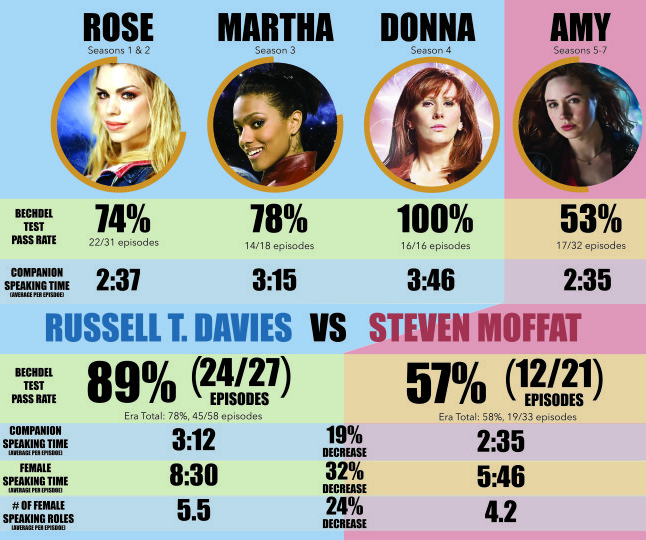For years now, many Doctor Who fans have been complaining that the show’s portrayal of female characters is getting worse and worse.
These accusations aren’t helped by showrunner Steven Moffat, who has gone on record saying that he probably wouldn’t cast a woman as the Doctor and making a vast array of sexist comments about female characters and actresses connected with Doctor Who and his other show, Sherlock. Doctor Who has only hired one female writer in the eight-season run of its 21st century reboot, and that was before Moffat took charge in 2008.
The counterargument to all this is that we should be judging Doctor Who on its own merits, rather than analyzing the opinions of its showrunner. While one fan might say that River Song and Amy Pond were reduced to plot devices to forward the Doctor’s manpain, other fans will inevitably disagree. It’s a matter of opinion, right?
To a certain extent, yes. What one viewer interprets as a pattern of sexism in the way Doctor Who portrays women, another person might say is just coincidence. Still, there’s one thing that isn’t a matter of opinion: cold, hard stats.
As part of a media studies research project, Doctor Who fan Rebecca Moore rewatched all of New Who with a group of other students, cataloguing various ways of measuring female representation on the show. With Moore’s permission, we’ve republished the infographic they created to illustrate these findings.

Via Rebecca Moore
In every regard, the amount of attention given to female characters decreased after Steven Moffat took over as showrunner.
During the Russell T. Davies era, 89 percent of episodes passed the Bechdel Test, but that dropped to 57 percent during the first three seasons of Moffat’s time as showrunner. The number of female roles decreased overall, as did the amount of time those characters spent speaking.
The high water mark was Davies’ final year as showrunner, when Donna Noble was the Doctor’s companion. During this season, every episode passed the Bechdel Test, and women had the most active speaking time overall. Since then, the Doctor seems to have been plunged into a disturbing horror story where women are vanishing and being silenced all around him, but nobody seems to notice.
These stats break down the show by the time each companion spent with the Doctor, but Moore also took River Song into account. Although River Song is never officially the Doctor’s main traveling companion, she has been a recurring character since season 4. Overall, her episodes pass the Bechdel Test 57 percent of the time, but Moore describes these passes as “barely scraping by.”
The test requires at least two named female characters to talk about something other than a man, and whenever River Song’s episodes manage this, it’s always a single three- or four-line exchange that takes place in front of the Doctor.
Combined with the less scientific criticisms we’ve seen from many other Doctor Who fans, these results are pretty damning.
Amy Pond, River Song, and Clara (the three main female characters of the Moffat era) have all been criticized for being inconsistently written or accused of being accessories to the Doctor’s storyline rather than individuals in their own right. How are Moffat’s female characters meant to evolve past these perceptions, if they are getting less and less time to speak?
Of course, it’s entirely possible to create a TV show or movie that has relatively few speaking roles for women but still portrays women as powerful and interesting individuals with equal agency to their male counterparts; Gravity and Alien are both good examples. However, it’s difficult to argue that recent seasons of Doctor Who have lived up to this standard. As a TV series with multiple openings for new side-characters in every episode, it has ample opportunities to pass simple milestones like the Bechdel Test. Sadly, those opportunities are going to waste.
At its best, Doctor Who is still a show with an effectively immortal white male protagonist. He is indispensable, while his (usually female) sidekicks are replaced every few years.
For this reason, virtually every episode is dominated by the voice, desires, and ongoing character arc of a white male character. Until the Doctor is played by someone who isn’t a white man, this will always be the case. Which is why it’s important not just to give his female companions a more significant voice, but to include more diversity in the show, period.
Photo via doctorwho/Tumblr
